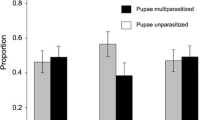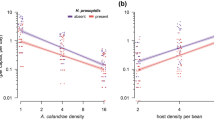Abstract
This paper reports on an asymmetric indirect interaction between two chrysomelid beetles where one species (Galerucella tenella) experiences higher parasitization, and the other species (Galerucella calmariensis) lower parasitization, in mixed compared with monospecific populations. This pattern is likely to be a consequence of differences in life history characteristics, where the inferior species has a smaller body size, a lower fecundity and supports a lower parasitoid density than the superior species. This connection between life history characteristics and interspecific dominance in host–parasitoid systems corresponds to predictions from current community ecology theory, and provides a useful building-block in the development of a predictive theory of parasitoid effects on host coexistence.



Similar content being viewed by others
References
Abrams PA, Holt RD, Roth JD (1998) Apparent competition or apparent mutualism? Shared predation when populations cycle. Ecology 79:201–212
Askew RR, Viggiani G (1978) Two new species of Asecodes Foerster (Hym., Eulophidae) parasitic upon Galeruca spp. (Col., Chrysomelidae) in Italy. Boll Lab Entomol Agraria ‘Filippo Silvestri’ 35:43–48
Blossey B (1992) Impact of Galerucella pusilla and G. calmariensis (Coleoptera: Chrysomelidae) on field populations of purple loosestrife (Lythrum salicaria). In: Delfosse ES, Scott RR (eds) Proceedings of the 8th international symposium on biological control of weeds. DSIR/CSIRO, Melbourne, pp 27–31
Bonsall MB, Hassell MP (1997) Apparent competition structures ecological assemblages. Nature 388:371–373
Bonsall MB, Hassell MP (1999) Parasitoid-mediated effects: apparent competition and the persistence of host–parasitoid assemblages. Res Popul Ecol (Kyoto) 41:59–68
Bonsall MB, Hassell MP (2000) The effects of metapopulation structure on indirect interactions in host–parasitoid assemblages. Proc R Soc Lond B 267:2207–2212
Brassil CE, Abrams PA (2004) The prevalence of asymmetrical indirect effects in two-host–one-parasitoid systems. Theor Popul Biol 66:71–82
Chaneton EJ, Bonsall MB (2000) Enemy-mediated apparent competition: empirical patterns and the evidence. Oikos 88:380–394
Dolgin MM (1979) Asecodes mento Walker (Hymenoptera, Chalcidoidea, Eulophidae), a parasite of the water-lily beetle (Galerucella nymphaeae) in the Altai. Entomol Rev 58:145–147
Doutt RL, Nakata J (1973) The Rubus leafhopper and its egg parasitoid: an endemic biotic system useful in grape-pest management. Environ Entomol 2:381–386
Hambäck P (2004) Why purple loosestrife in sweet gale shrubs are less attacked by herbivorous beetles? (in Swedish with English abstract). Entomol Tidskr 125:93–102
Hambäck PA, Beckerman AP (2003) Herbivory and plant resource competition: a review of two interacting interactions. Oikos 101:26–37
Hambäck PA, Björkman C (2002) Estimating the consequences of apparent competition: a method for host–parasitoid interactions. Ecology 83:1591–1596
Hambäck PA, Ekerholm P (1997) Mechanisms of apparent competition in seasonal environments: an example with vole herbivory. Oikos 80:276–288
Hambäck PA, Ågren J, Ericson L (2000) Associational resistance: insect damage to purple loosestrife reduced in thickets of sweet gale. Ecology 81:1784–1794
Hambäck PA, Pettersson J, Ericson L (2003) Are associational refuges species-specific? Funct Ecol 17:87–93
Hansson C (1996) The status of the genera Asecodes Förster, Ionympha Graham and Teleopterus Silvestri (Hymenoptera: Eulophida), with a review of Nearctic species. Entomol Scand 27:159–167
Hawkins BA, Thomas MB, Hochberg ME (1993) Refuge theory and biological control. Science 262:1429–1437
Heimpel GE, Neuhauser C, Hoogendoorn M (2003) Effects of parasitoid fecundity and host resistance on indirect interactions among hosts sharing a parasitoid. Ecol Lett 6:556–566
Hight SD, Blossey B, Laing J, Declerck-Floate R (1995) Establishment of insect biological control agents from Europe against Lythrum salicaria in North America. Environ Entomol 24:967–977
Hippa H, Koponen S (1984) Parasitism of larvae of Galerucini (Col., Chrysomelidae) by larvae of Asecodes mento (Hym., Eulophidae). Rep Kevo Subarctic Res Station 19:63–65
Holt RD (1977) Predation, apparent competition, and the structure of prey communities. Theor Popul Biol 12:197–229
Holt RD, Barfield M (2003) Impacts of temporal variation on apparent competition and coexistence in open ecosystems. Oikos 101:49–58
Holt RD, Lawton JH (1993) Apparent competition and enemy-free space in insect host–parasitoid communities. Am Nat 142:623–645
Holt RD, Lawton JH (1994) The ecological consequences of shared natural enemies. Annu Rev Ecol Syst 25:495–520
Hoogendoorn M, Heimpel GE (2002) Indirect interactions between an introduced and a native ladybird beetle species mediated by a shared parasitoid. Biol Control 25:224–230
Katovich EJS, Becker RL, Ragsdale DW (1999) Effect of Galerucella spp. on survival of purple loosestrife (Lythrum salicaria) roots and crowns. Weed Sci 47:360–365
Luhring KA, Millar JG, Paine TD, Reed D, Christiansen H (2004) Ovipositional preferences and progeny development of the egg parasitoid Avetianella longoi: factors mediating replacement of one species by a congener in a shared habitat. Biol Control 30:382–391
Manly B, McDonald L, Thomas D (1993) Resource selection by animals. Chapman and Hall, London
Morris RJ, Lewis OT, Godfray HCJ (2004) Experimental evidence for apparent competition in a tropical forest food web. Nature 428:310–313
Müller CB, Godfray HCJ (1997) Apparent competition between two aphid species. J Anim Ecol 66:57–64
van Nouhuys S, Hanski I (2000) Apparent competition between parasitoids mediated by a shared hyperparasitoid. Ecol Lett 3:82–84
Reitz SR, Trumble JT (2002) Competitive displacement among insects and arachnids. Annu Rev Entomol 47:435–465
Schmidt KA, Whelan CJ (1998) Predator-mediated interactions between and within guilds of nesting songbirds: experimental and observational evidence. Am Nat 152:393–402
Sebolt DC, Landis DA (2002) Neonate Galerucella calmariensis (Coleoptera: Chrysomelidae) behavior on purple loosestrife (Lythrum salicaria) contributes to reduced predation. Biol Control 31:880–886
Settle WH, Wilson LT (1990) Invasion by the variegated leafhopper and biotic interactions: parasitism, competition, and apparent competition. Ecology 71:1461–1470
Siekmann G, Keller MA, Tenhumberg B (2004) The sweet tooth of adult parasitoid Cotesia rubecula: ignoring hosts for nectar? J Insect Behav 17:459–476
Sokal RR, Rohlf FJ (1995) Biometry. Freeman, San Francisco
Teder T, Tammaru T (2003) Short-term indirect interactions between two moth (Lepidoptera: Noctuidae) species mediated by shared parasitoids: the benefits of being scarce. Eur J Entomol 100:323–328
Acknowledgements
This paper was improved through comments by Bob Holt, Thomas Hoffmeister and an anonymous referee, and the language was checked by Helen Quested. We thank Anna Sandhammar, Anna-Maria Eriksson, Aron Ericson, Ingrid Ericson, Miriam Ericson, Staffan Ericson and Einar Nordström who assisted in field and laboratory studies. Funding was provided by the Swedish Research Council (Vetenskapsrådet) to L.E. and P.A.H.
Author information
Authors and Affiliations
Corresponding author
Additional information
Communicated by Thomas Hoffmeister
Rights and permissions
About this article
Cite this article
Hambäck, P.A., Stenberg, J.A. & Ericson, L. Asymmetric indirect interactions mediated by a shared parasitoid: connecting species traits and local distribution patterns for two chrysomelid beetles. Oecologia 148, 475–481 (2006). https://doi.org/10.1007/s00442-006-0387-2
Received:
Accepted:
Published:
Issue Date:
DOI: https://doi.org/10.1007/s00442-006-0387-2




